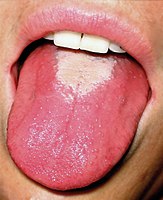
Photo from wikipedia
Purpose Riboflavin deficiency causes ariboflavinosis, a common nutritional deficiency disease. The purpose of this study is to investigate the effects of riboflavin deficiency on the important internal organs and its… Click to show full abstract
Purpose Riboflavin deficiency causes ariboflavinosis, a common nutritional deficiency disease. The purpose of this study is to investigate the effects of riboflavin deficiency on the important internal organs and its potential mechanisms. Methods Experiment 1, male F344 rats were randomly assigned to R 6 (normal riboflavin, 6 mg/kg) and R 0 (riboflavin-deficient, 0 mg/kg) groups. Experiment 2 rats were assigned to R 6 , R 0.6 (0.6 mg/kg) and R 0.06 (0.06 mg/kg) groups. Experiment 3 rats were assigned to R 6 and R 0 → R 6 (riboflavin replenishment) groups. Bacterial communities were analyzed based on 16S rRNA gene sequencing. Results Riboflavin deficiency induced ariboflavinosis (R 0.06 46.7%; R 0 72%) and esophageal epithelial atrophy (R 0.06 40%; R 0 44%) in rats, while the R 6 group did not display symptoms ( P < 0.001, respectively). Esophageal epithelial atrophy occurred simultaneously (R 0.06 66.7%; R 0 63.6%) with ariboflavinosis or appeared alone (R 0.06 33.3%; R 0 36.4%). Esophagus is the most vulnerable internal organ. Riboflavin deficiency followed by replenishment (R 0 → R 6 ) was effective in treating ariboflavinosis (83.3% vs. 0%, P < 0.001) and esophageal epithelial atrophy (66.7% vs. 20%, P = 0.17). Riboflavin deficiency modulated gut microbiota composition. The several key genera ( Romboutsia , Turicibacter and Clostridium sensu stricto 1 ) were strongly correlated with ariboflavinosis and esophageal epithelial atrophy ( P < 0.01 or P < 0.05). The potential mechanism is that gut microbiota affects body's xenobiotic biodegradation and metabolism, and genomic instability. Conclusions Riboflavin deficiency induces ariboflavinosis and esophageal epithelial atrophy by modulating the gut microbiota, and offers new Queryinsight into riboflavin deficiency and esophageal lesions.
Journal Title: European Journal of Nutrition
Year Published: 2020
Link to full text (if available)
Share on Social Media: Sign Up to like & get
recommendations!